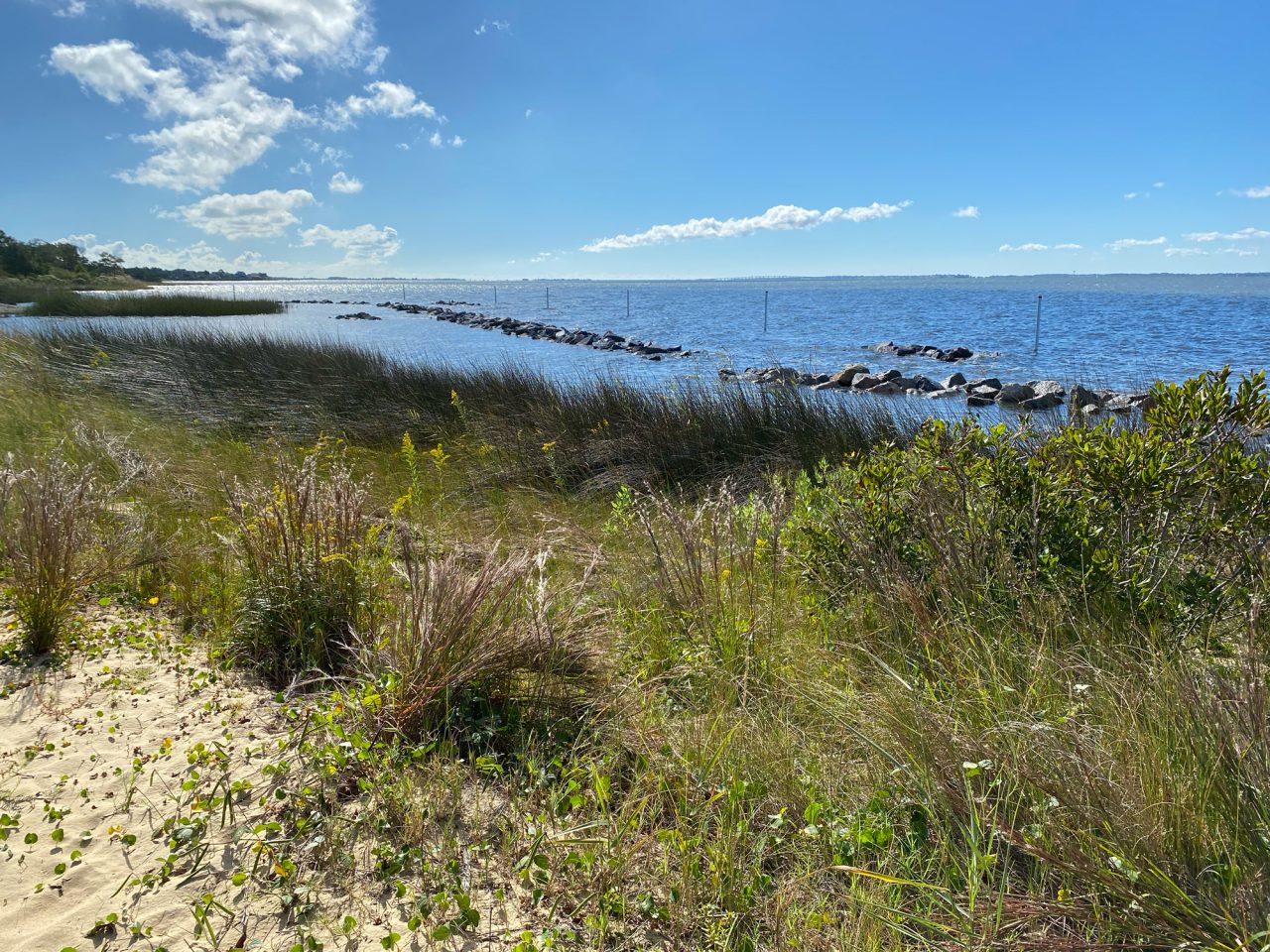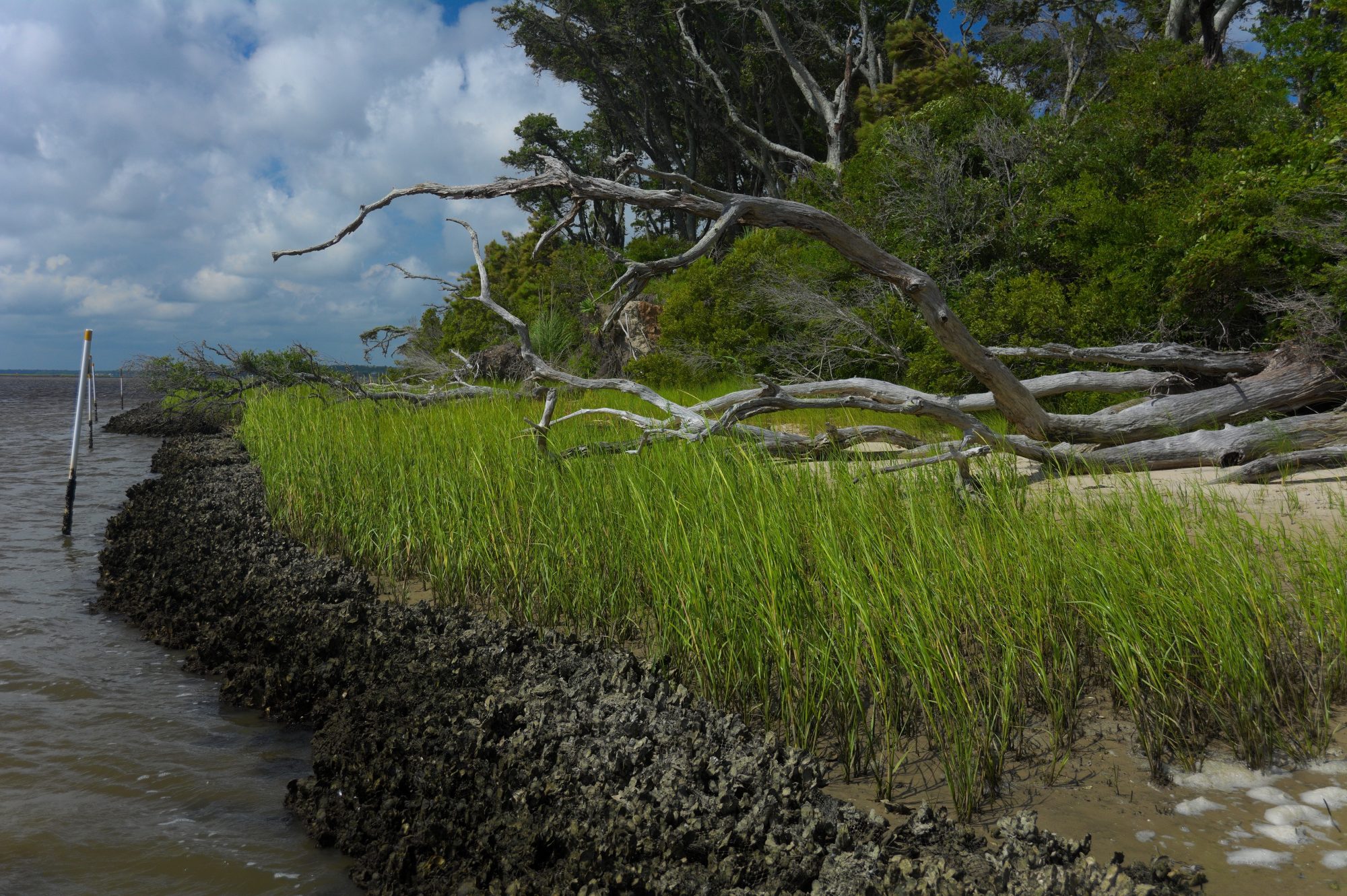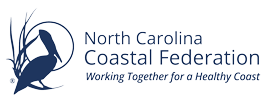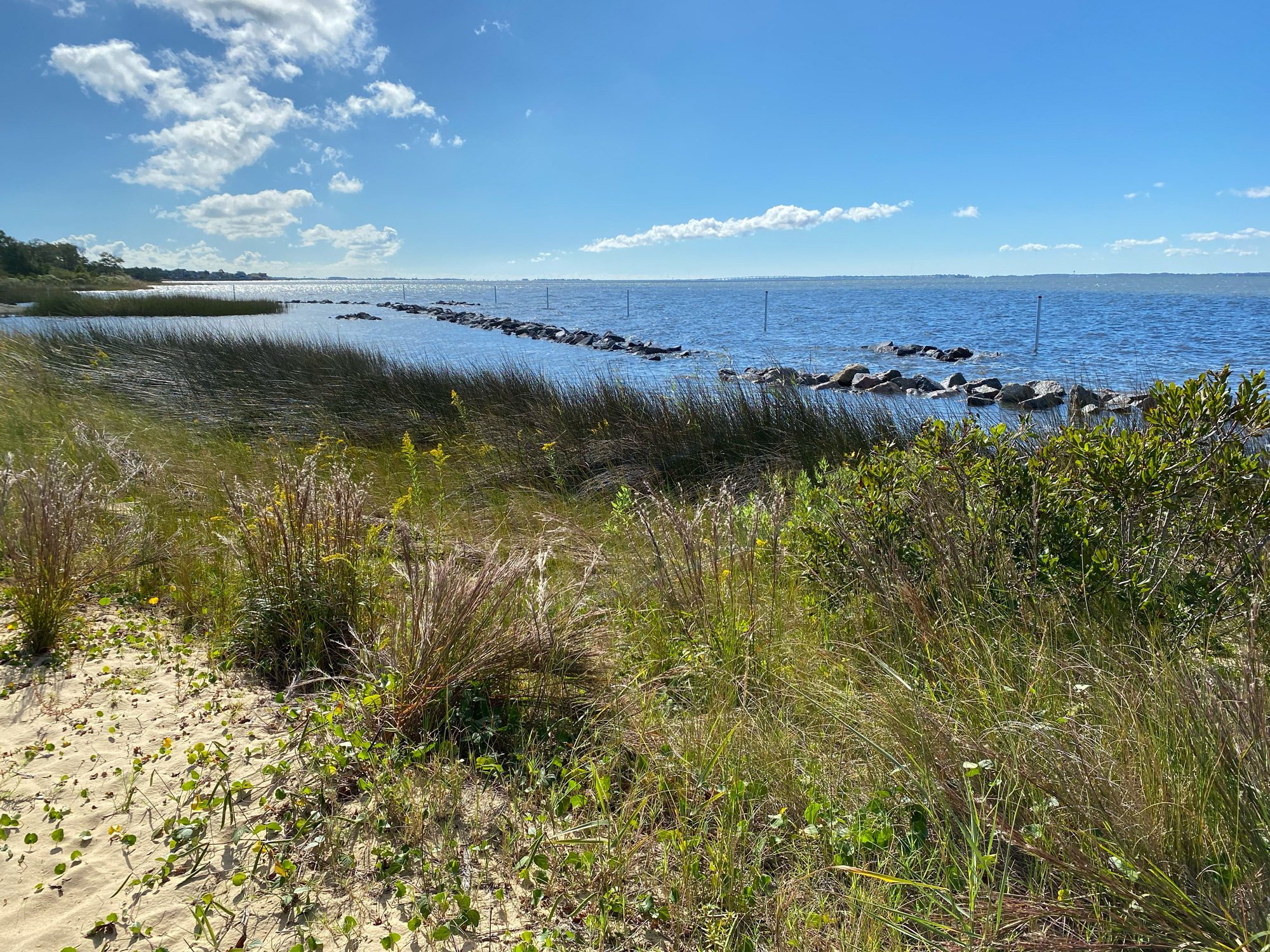North Carolina’s 12,000 miles of estuarine shoreline provide some of the most productive habitats in the world for fish and shellfish.
Unfortunately, the erosion of these shorelines is increasing because of rising sea levels, concentrated waves from boats, more extreme storms, and poorly planned development practices. Erosion control structures like bulkheads are not as effective as living shorelines in protecting shorelines. By installing buffers using salt marshes, oyster reefs, and other natural materials, living shorelines control erosion while protecting the natural beauty and productivity of our estuaries.
The Coastal Federation remains committed to making living shorelines the go-to approach for managing shoreline erosion. We have secured public and private funding that will help us provide increased financial incentives to landowners for living shorelines.
Living shorelines offer an effective, natural way to address estuarine shoreline erosion.
FAQs
What are the benefits of living shorelines?
Living shorelines offer many benefits, including the following:
- Provide food and shelter for many creatures.
- Serve as critical nurseries for many important marine species.
- Filter pollutants from stormwater runoff, the most significant water quality pollutant in North Carolina.
- Protect the land from wave energy, storm surges and tides.
- Provide aesthetic value, enhanced views, a sense of place and privacy.
Why living shorelines?
The Federation maintains that the best way to deal with erosion is to plan for it, to build as far as possible from the water’s edge, and to retreat when the time comes.
When that’s not possible, the Federation recommends using stabilization methods that maintain the natural integrity of the marsh and do the least damage to them. Living shorelines are one method of doing that.
Livings shorelines use as many natural elements as appropriate for the site to protect the shoreline from erosion. Specific materials include bags of oyster shells, native marsh grasses, wood, limestone, rip rap, or constructed ‘oyster domes’. They range from construction setbacks and simple plantings of marsh grass to more complex approaches that use the materials listed above or other structures to dampen wave energy.
No two shorelines are the same, and living shoreline strategies must be selected based on:
- Existing land uses.
- The amount of wave energy at the site.
- Individual local conditions.
The Federation and many other organizations consider this method a better alternative than traditional bulkheads or walls. Bulkheads reflect the wave energy back along the shoreline, which worsens erosion. Living shorelines act as a natural buffer, absorbing the wave energy, minimizing shoreline erosion, and protecting the marsh.
The Federation has designed, constructed, and monitored dozens of living shoreline projects all over the coast. Several renowned scientists, such as Carolyn Currin, Rachel Gittman, and Lexia Weaver, have assessed these living shorelines and, in summary, they work.
The habitat values, erosion control, and filter effects of living shorelines compare well with natural marsh and perform significantly better than bulkheads.
Learn how living shorelines outperform bulkheads during storms and cost less to repair.
What kinds of creatures live around living shorelines?
Check out the ones the federation has spotted around their living shorelines:
- Blue crabs
- Stone crabs
- Mud crabs
- Hermit crabs
- Shrimp
- Mussels
- Fish! Mummichog, killifish, anchovies, silversides, mullets, pin fish and many more juveniles and adult species.
- Starfish
- Sea squirts
- Slipper shells
- Snails
- Barnacles
- Herons
- Pelicans
- Osprey
- Skimmers
- Terns
Interested in building a living shoreline on your property? Please send an email to livingshorelines@nccoast.org to receive more information. There is now cost-share funding available for those interested in building a living shoreline on your property.
Current Work
Our work to promote living shorelines is being advanced with a $2 million appropriation from N.C. General Assembly as well as other state and federal grants. With public and private funds, we will build over 3,000 feet of living shorelines on private properties.
By working with contractors, students, and community volunteers we’ll enhance at least 400 feet of existing living shoreline at Jockey’s Ridge State Park; build an additional 200 feet of living shoreline at Carteret County’s future boat ramp location in Ocean; construct 800 feet and design and permit another 845 feet of living shorelines along NC Hwy 24 in Cedar Point and Swansboro.

We’ll also design, permit and begin the construction of 1,667 feet of living shoreline at MCAS Cherry Point and 2,408 feet of living shoreline at Fort Macon State Park. We plan to build 60 feet of living shoreline at Topsail Beach and begin construction of five acres of oyster, living shoreline, and salt marsh; and 13 acres of tidal creek and marsh at Carolina Beach State Park. In addition, we will secure funding and permits for 150 feet of demonstration living shoreline using oyster castles and OysterCatcher™ materials, and maintain 1,860 feet of existing living shoreline at Morris Landing.
We continue to test more environmentally acceptable materials for living shoreline construction, provide continuing education for public officials, contractors, and real estate professionals and work with researchers to increase public understanding of the value of living shorelines.
2024 Highlights
feet of living shorelines installed
living shoreline projects
wetland grasses planted
Featured Projects
Project summaries from the blog:

Living Shorelines Academy
The Living Shorelines Academy was established to increase the abundance of coastal wetlands, advance the policy, science and practice of living shorelines, and enhance collaboration among governmental and private stakeholders. It is funded by the Environmental Protection Agency (EPA) and is a product of collaboration between Restore America’s Estuaries and the North Carolina Coastal Federation — and their many partners.
The Academy provides training modules, research and reports, a database of existing living shoreline projects, a directory of professionals, and a forum.
Resources

Other resources from around the web:
- List of Marsh Grass Suppliers from N.C. Sea Grant
- Living Shoreline Suitability Tool — The Nature Conservancy has partnered with scientists at NOAA’s Beaufort Lab to create this new application by bringing in their research on shorelines in the southern Pamlico, Core, and Bogue sounds and the New River Estuary so that managers and residents can identify where to apply more natural techniques to stabilize their shores. This tool identifies where shoreline wave energy conditions are suitable to ensure successful living shoreline projects.
- “From Gray To Green: Replacing A Bulkhead With A Living Shoreline At A High-Energy Riverine Site” — NOAA Office for Coastal Management
- Green Infrastructure Benefits — NOAA Office for Coastal Management
- Coastal Blue Carbon as an Incentive for Coastal Conservation, Restoration and Management: A Template for Understanding Options

Resilient Shorelines
You can help make a difference for our coast—one living shoreline at a time!


